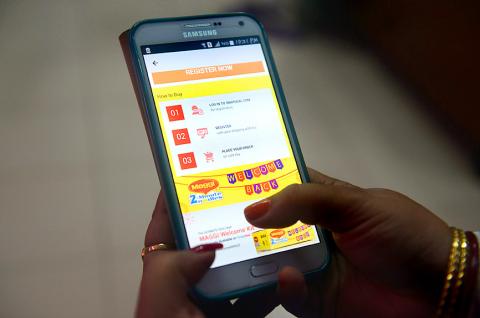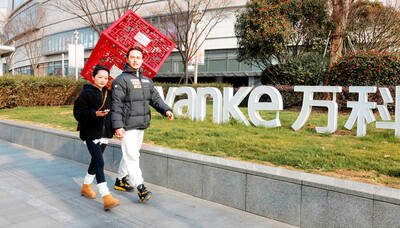Hundreds of layoffs at several Indian start-ups have sparked fears the bubble is starting to burst for the country’s e-commerce companies, amid claims by analysts that many of them are overvalued.
Restaurant search Web site Zomato, food delivery app TinyOwl and property portal Housing.com are all letting staff go, and experts are warning of echoes of the dot-com boom which crashed spectacularly in 2000.
“The valuation bubble is bursting. The valuations had reached levels where they were ridiculous and could not be justified at any level,” said Arvind Singhal, chairman of management consulting firm Technopak Advisors Pvt Ltd.

Photo: AFP
Wealthy investors boosted by low interest rates have been lining up to lavishly back India’s booming start-ups, with the government hailing the sector as proof of the country’s entrepreneurial spirit.
Indian Prime Minister Narendra Modi views online start-ups as key to providing jobs to aspirational young Indians, seeking to fuel the sector through a government campaign, “Start up India, Stand up India.”
In September he visited Silicon Valley, calling on deep-pocketed investors to turn their attention to India’s thriving start-up ecosystem, with large tech hubs in the cities of Bengaluru, Hyderabad and Mumbai.
Yet despite the billions of US dollars invested in recent years, most of India’s online start-ups are yet to turn profits and investments are largely based on speculative future earnings.
“Investors are not looking objectively at the sector right now. They are just seeing a few success stories and ignoring the failures, just like they did in the dot-com era,” said Paras Adenwala, investment consultant at Capital Portfolio Advisors in Mumbai.
Adenwala is concerned that once the US central bank starts moving on interest rates, as it has long been tipped to do, investors would be less generous with their cash, making the situation worse.
“You would see a lot of these start-ups falling by the wayside once the US Federal Reserve starts raising rates and funding dries up,” he said.
Recent job cuts at TinyOwl Technology Pvt Ltd, Zomato Media Pvt Ltd and Housing.com suggest that not all is well.
TinyOwl co-founder and chief executive Harshvardhan Mandad said the redundancies had been necessary to get the start-up on a more sustainable footing, while an official at Zomato said the restructuring that led to the redundancies was based on a business call.
“I do not think that the pace of growth has suddenly slowed. Is the market correcting? Perhaps it is and I guess it’s about time that happened as well,” said the Zomato official, who asked not to be named.
Grofers, a “hyperlocal” grocery app that allows customers to order goods from corner shops online, last month made two acquisitions in a week, taking over its shuttered competitor Townrush and meal delivery service SpoonJoy.
And earlier this month Mumbai-based CarTrade, a portal for selling used autos, acquired its rival CarWale for an undisclosed sum.
Singhal sees the job cuts as part of an inevitable “evolution” of start-ups, where the early movers lacked well thought-out business models but successors are to learn from their mistakes.
“It would encourage new start-ups with clearer plans,” he said.

CHIP RACE: Three years of overbroad export controls drove foreign competitors to pursue their own AI chips, and ‘cost US taxpayers billions of dollars,’ Nvidia said China has figured out the US strategy for allowing it to buy Nvidia Corp’s H200s and is rejecting the artificial intelligence (AI) chip in favor of domestically developed semiconductors, White House AI adviser David Sacks said, citing news reports. US President Donald Trump on Monday said that he would allow shipments of Nvidia’s H200 chips to China, part of an administration effort backed by Sacks to challenge Chinese tech champions such as Huawei Technologies Co (華為) by bringing US competition to their home market. On Friday, Sacks signaled that he was uncertain about whether that approach would work. “They’re rejecting our chips,” Sacks

Taiwan’s long-term economic competitiveness will hinge not only on national champions like Taiwan Semiconductor Manufacturing Co. (TSMC, 台積電) but also on the widespread adoption of artificial intelligence (AI) and other emerging technologies, a US-based scholar has said. At a lecture in Taipei on Tuesday, Jeffrey Ding, assistant professor of political science at the George Washington University and author of "Technology and the Rise of Great Powers," argued that historical experience shows that general-purpose technologies (GPTs) — such as electricity, computers and now AI — shape long-term economic advantages through their diffusion across the broader economy. "What really matters is not who pioneers

BUBBLE? Only a handful of companies are seeing rapid revenue growth and higher valuations, and it is not enough to call the AI trend a transformation, an analyst said Artificial intelligence (AI) is entering a more challenging phase next year as companies move beyond experimentation and begin demanding clear financial returns from a technology that has delivered big gains to only a small group of early adopters, PricewaterhouseCoopers (PwC) Taiwan said yesterday. Most organizations have been able to justify AI investments through cost recovery or modest efficiency gains, but few have achieved meaningful revenue growth or long-term competitive advantage, the consultancy said in its 2026 AI Business Predictions report. This growing performance gap is forcing executives to reconsider how AI is deployed across their organizations, it said. “Many companies

China Vanke Co (萬科), China’s last major developer to have so far avoided default amid an unprecedented property crisis, has been left with little time to keep debt failure at bay after creditors spurned its proposal to push back a looming bond payment. Once China’s biggest homebuilder by sales, Vanke failed to obtain sufficient support for its plan to delay paying the 2 billion yuan (US$283.51 million) note due today, a filing to the National Association of Financial Market Institutional Investors showed late on Saturday. The proposal, along with two others on the ballot, would have allowed a one-year extension. All three